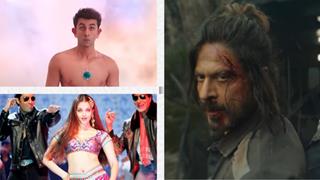Directed by Apoorva Lakhia
Rating: **
You've to hand it to these guys. They sure know how to shoot a gun straight from the hip. Watch Sanjay Dutt, gun shoved into his trousers, striding in leonine slow motion, into the hideout of the five scintillating scumbags.
Yup, screen heroism lives even when it is underscored by docu-realism.
This is the ultimate cops-and-gangsters thriller....If one may go back to genre-specific definitions for a film that breaks many rules, with insouciant energy.
Shootout At Lokhandwala is a work that targets to bump off all the clichés of gangsters epics while resorting to those very trite-and-tested conventions of the genre (rust-brown ambience, stubbles-and-gaalis, the works) that makes the gangster epic what it is.
There're the cops, offhandedly heroic, with little-little family backgrounds to give them a human subtext.
Then there are the criminals, selfconsciously scruffy (specially Viveik Oberoi who wears his unwashed look like second sin...and I do mean, sin). They all strut around like they've watched the collected works of Sanjay Gupta abd Ram Gopal Varma minutely.
But has director Apoorva Lakhia been able to reinvent and re-energize the whole process of gangsterism?
 The editing (Bunty Nagi) brings a new language of gangsterism into play. Almost every sequence moves concurrently from current time to the past to recreate all the incidents that led to the rat-like hounding,cornering and killing of the five gangsters who are a law unto themselves.
The editing (Bunty Nagi) brings a new language of gangsterism into play. Almost every sequence moves concurrently from current time to the past to recreate all the incidents that led to the rat-like hounding,cornering and killing of the five gangsters who are a law unto themselves.This is the only gangster film in loving memory with no punctuation marks. No shot in the entire larger-than-strife films on murky morality lasts longer than five seconds. But within that selflimited footage the narrative scans the faces and souls of these ruthless gangsters and cops with savage candour.
Those of us who have virtually grown older watching producer Sanjay Gupta's tentacled treatise on violence would immediately recognize the simmering undercurrents of faustian perversity in the wily and bludgeoning way morals are mixed mingled and finally mangled.
Watch Mr Amitabh Bachchan as the wry sarcastic lawyer quizzing the cops about the encounter as it (the encounter) is recreated for our and perhaps for posterity's benefit. "There's no difference between those gangsters whom you slayed and you guys," says the Big B disdainfully.
Mr Bachchan's transformation from a disbelieving moralist to an 'encounter' believer is a walk that the restless narrative takes on, sometimes on thin ice.
The constantly-charged adrenaline-driven narrative moves across gullies and roads with a ricocheting effect. The ear-splitting soundtrack reverberates with sounds of guns and ganas. The item songs in the beer bar are a rude reminder of how much the original true-life material needed to be re-worked for it to be audience-friendly.
Often you feel the narrative is being manipulated to appear more engrossing than it must have been 25 years ago when the incident actually happened.
There's a quality of enforced breathlessness, like a respirator on the verge of going on the blink, as the plot builds up to the cataclysmic finale in the building at Lokhandwala where the bang-gang comes to a gruesome end.
 Attempts to 'humanize' the criminals, with each of the five doomed criminals, calling home to sob and repent (only Rohit Roy moves us) appearing to be a half-hearted tradeoff to sentimentality.
Attempts to 'humanize' the criminals, with each of the five doomed criminals, calling home to sob and repent (only Rohit Roy moves us) appearing to be a half-hearted tradeoff to sentimentality. The plot is pumped up with adrenaline, leaving practically no part of the real-life encounter to chance. While Anil Mohile's background score over-punctuates the narrative, Gururaj Jois' camera wanders through these tormented lives and their dingy hide-outs unheedful of narrative conventions.
The effort to amalgamate documented evidence with cinematic conventions isn't always sure-footed. But like those corpses that fill up the screen at the end, the film is scattered with images and characters that wear a pall of doom with great composure.
The narrative holds your attentions specially because the familiar gangsters saga gets its energy from an unorthodox editing pattern. Then there are the performances. Some, like Sanjay Dutt and Amrita Singh are effortlessly intense.
Others, like Viveik Oberoi and Ahabbir Ahluwalua strain for effect. Then there are those like Arbaaz Khan an Suniel Shetty who merge into the febrile fabric of crime –busting. At the end of the dread, the actors hold the characters and our attention, in place.
Then there's Mr Bachchan, listening attentively to the cops unravel their tale of grisly stock-taking. We are riveted too.
Our attentions are taken up by the painstaking detailing of the period...the phone booths, the crumbling buildings, the smoky skyline ...all reminding us that the more things change, the more they are the same.
The same goes for gangster flicks.



















